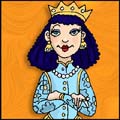
Read the information then click on the links below it to do the exercises.
WHAT IS PURIM AND WHEN DO WE CELEBRATE IT?
Purim is a joyous festival. It celebrates the story of how Queen Esther saved the Jewish people of Persia from being killed by the evil Haman.
The name Purim comes from the Persian word ‘pur’, which means ‘lot’ (as in ‘lottery’). This is because Haman cast lots (made a lottery) to decide the day on which he would kill all the Jews.
We celebrate Purim on the 14th day of the Hebrew month of Adar.

HOW DO WE CELEBRATE PURIM?
EATING A FESTIVE MEAL
We eat a festive meal on the day of Purim (though not on the previous night). It is a mitzvah (good deed) for adults to drink wine and be merry on Purim, even to the point of getting drunk.
MISHLOACH MANOT (sending gifts) & MATANOT L’EVIONIM (gifts to the poor)
On Purim we send gifts to our friends, often in festive baskets. School children usually exchange Mishloach Manot with their friends and prepare gifts to give or send to people less fortunate.
WEARING FANCY DRESS COSTUMES
Since an important idea in the story of Purim is hiding and disguise (Esther hid her Jewishness from the King), dressing up in costume is a favourite Purim custom. Outside Israel it is mainly children who dress up, but in Israel and in religious communities everyone does it.
PURIM GAMES
To increase the fun of Purim, we play special games. The Talmud talks about an ancient game called Meshavarta de’Purim, in which wood and tar are burnt in the ground and children then dance around or jump over the bonfire.
EATING PURIM FOODS
There are lots of foods which we eat on Purim, and many of them also remind us of the idea of hiding. The most popular Purim food is hamantashen, pastries which have jam and other fillings hidden inside them.

THE STORY OF PURIM
The story of Purim happened many years ago in the land of Persia. King Achashverosh married a beautiful Jewish woman by the name of Esther. Esther had an uncle, Mordechai, who had looked after her since the death of her parents. He told her she should hide her Jewishness from the King.
Haman, one of the King’s top advisors, was an evil and vain man who demanded that everyone bow down to him. When Mordechai would not bow down to him (being Jewish, he would only bow down to God), Haman became very very angry and decided to kill Mordechai along with all the Jewish people.
To set the date on which he would carry out this plan, Haman cast lots (‘purim’). The date was the 13th Adar. Mordechai told Esther about Haman’s plan and asked her to tell the king.
This was easier said than done, as it was the custom in Persia at that time that people could only go to the King if he invited them. Even his wife, Queen Esther, was supposed to wait to be invited. To ask for God’s help in breaking this rule, Esther asked all the Jews to fast for three days before she went uninvited to the King.
Meanwhile, Haman had put up a gallows on which he planned to hang Mordechai. When the King heard about Haman’s plan from Esther, he ordered that Haman be hanged there instead.
Achashverosh was reminded that years before, Mordechai had saved his life; to honour him, he made Mordechai his top advisor instead of Haman.
So, instead of being killed on the 13th of Adar, Mordechai and the Jews of Persia were saved.
Mordechai sent letters rolled into scrolls to all the people in the kingdom, telling them what the King had done to Haman. The next day was declared a holiday and ever since, Jews have celebrated Purim.
GOD’S MISSING NAME
Megilat Esther is the only book in the Tanach in which God’s name does not appear. Some reasons are that:
• The miracle of Purim occurred less than a hundred years after the First temple and Jerusalem were destroyed. At that time, many Jewish people were doubting a God who would let such a tradedy happen to His chosen people.
• The rabbis write that it was a time when people struggled to find the “face of God”, which means they struggled to believe in Him.
• The miracles that God performs in the Purim story are through the actions of people like Queen Esther. This would have been a more acceptable "story-telling" device for the Jewish people of that time.

A SPECIAL PRAYER FOR PURIM
For all the miracles, for the liberation, for the mighty deeds, for the victories in battles which you performed for our ancestors in those days, at this time of year.
In the days of Mordechai and Esther, in Shushan, the capital, wicked Haman opposed them. He tried to destroy, to kill and to wipe out all the Jews young and old, babies and women,on one day, the thirteenth day of the twelth month, which is Adar, and also to take all their belongings as loot.
But You, in your great mercy, upset his intention and destroyed his plan and made his scheme rebound on his own head, so that he and his sons were hanged on the gallows.
|
|